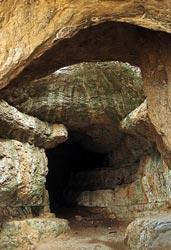Szelim cave
This article needs additional citations for verification. (May 2010) |
Szelim-barlang | |
 Szelim cave | |
| Location | Gerecse Mountains, near Tatabánya |
|---|---|
| Region | Komárom-Esztergom County, Central Transdanubia, Hungary |
| Coordinates | 47°35′25″N 18°24′25″E / 47.59028°N 18.40694°E / 47.59028; 18.40694 |
| Length | 45 m (148 ft) |
| Height | 14 m (46 ft) |
| History | |
| Material | karst, limestone |
| Periods | Upper Paleolithic |
| Site notes | |
| Excavation dates | 1932, 1934 |
| Archaeologists | Hubert Kessler, István Gaál |
The Szelim cave (Hungarian: Szelim-barlang or Szelim-lyuk (Szelim hole), Bánhidai nagy barlang (Bánhidian big cave), Eperjes-barlang, Szemi-luki, Szemi-lyuka, Szelimluk barlang, Bánhidai-zsomboly, Szent Vit-barlang) is located in northwestern Hungary at the western margin of the Gerecse Mountains, 289 m (948 ft) above the Által-ér Valley near Tatabánya city. The cave interior is 45 m (148 ft) long and 14 m (46 ft) high. The site has been regularly frequented and used as a shelter by local villagers over the centuries, is easily accessible and its huge rectangular entrance features a memorial of the Turul.[1]

Geology
The karstic cave was formed during the Upper Trias, has undergone and will further undergo extensive corrosion. Meteoric water infiltrates the compact Mesozoic limestone and is going to carve cavities into the bedrock, solve the limestone and abrade the cavities with the debris and rocks.
Excavations
The cave was recognized as an archaeological site only relatively late. In 1932 Hubert Kessler, the first promoter of speleological research, began excavations. The results of Kessler work encouraged István Gaál to start regular excavations. In 1934 the Natural History Research Council supplied - although insufficient - the financial means for further work. Remains of hearths, stoves, carvings, animal bones and human remains, some of which date to the era of Turkish invasions in early modernity were excavated.
The sediments are more than 12 m (39 ft) deep and rich in archaeological finds, that were extracted to the bedrock in a few months in most of the cave. More recent research results confirm the notion that human occupation in Szelim dates back as far as 200,000 years BP. Mousterian artefacts and stone tools discovered in the stratae date back to the Upper Paleolithic.
In 2013 the Hungarian Ministry of Interior declared the site a protected natural national asset.[2][1][3]
Legends of the cave
The cave is the subject of several historical legends.
- According to oral tradition the population of 7 neighboring villages escaped to the depths of the cave during the Turkish wars from Szelim sultan's troops who devastated Transdanubia. Unfortunately, the Turks found the people who were hidden there and killed them with the smoke of the bonfire they poured into the opening of the cave.[4]
- The population of the villages surrounding the refuge were being looked for in the cave at the time of the Tartar attacks. When a little boy became thirsty then started crying, his mother took him away the close to a water source. The Tartars, who captured the woman, compelled her to reveal the cache of the others, and then captured them there.
Pictures
References
- ^ a b Dobosi, Viola T. (2003). Palaeolithic Man in the Altal-er Valley (PDF). Komárom-Esztergo County Museum Directorate. pp. 16–17. ISBN 9637110313. Retrieved 18 August 2014.
- ^ Zsolt Mester. "Mousterian industries in Hungary – 15 years later". Academia Edu. Retrieved December 30, 2017.
- ^ "The study and historic reconstruction of the sedimentary sequence, in the Szelim Cave (Tatabánya)" (PDF). Electronic Periodical Archives and Database. Retrieved December 30, 2017.
- ^ Tatabánya:Fotoalbum ISBN 963-8103-42-6
External links
- Pictures of Szelim cave





